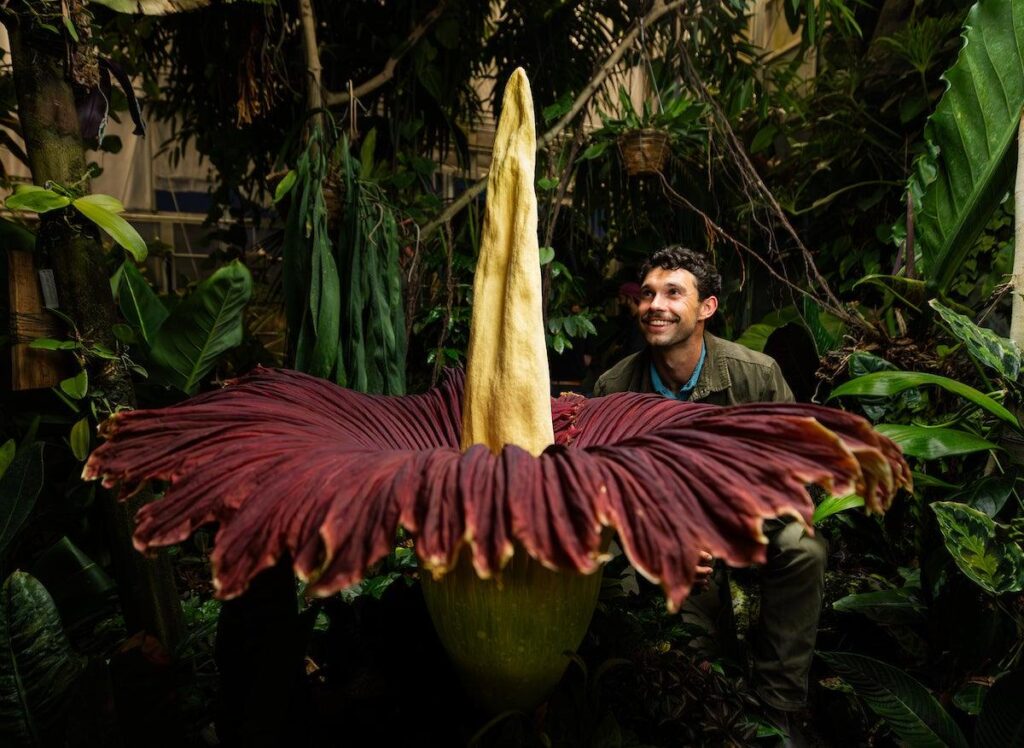Colorado State University’s corpse flower has once again captured attention-not for its rare bloom, but for the unmistakably foul odor it emits. Known for releasing a scent reminiscent of rotting flesh, this botanical marvel has long fascinated scientists and plant enthusiasts alike. In this article, we delve into the science behind the corpse flower’s notorious stench, exploring the chemical compounds responsible and the evolutionary reasons why CSU’s titan arum produces such a pungent smell.
The Chemical Composition Behind the Corpse Flower’s Foul Aroma
The distinctive and overwhelming stench emitted by CSU’s corpse flower is primarily the result of a complex blend of volatile organic compounds, each contributing uniquely to its notorious aroma. Scientists have identified that the primary offenders include dimethyl disulfide, dimethyl trisulfide, benzyl alcohol, and trimethylamine. Dimethyl disulfide and dimethyl trisulfide lend a sulfuric, rotten-cabbage scent, while benzyl alcohol adds a slightly sweet but decaying odor, and trimethylamine is reminiscent of rotting fish. These compounds work synergistically, creating a powerful bouquet that mimics the smell of decomposing flesh, cleverly evolved to attract carrion beetles and flesh flies for pollination.
Below is a simplified breakdown of some key chemicals contributing to the foul aroma:
| Chemical Compound | Smell Profile | Primary Role |
|---|---|---|
| Dimethyl Disulfide | Rotten cabbage | Warning scent, attracts pollinators |
| Dimethyl Trisulfide | Strong sulfuric odor | Enhances decay effect |
| Benzyl Alcohol | Sweet yet decaying | Complex aroma layering |
| Trimethylamine | Rotting fish | Signals corpse presence |
Understanding these components gives insight not only into the flower’s biological strategy but also reveals how chemical ecology is utilized to manipulate the senses of pollinators. This biochemical cocktail is a striking example of nature’s innovation in reproductive tactics, using powerful scents rather than colorful petals or nectar rewards to complete its life cycle.
How CSU Researchers Decode Nature’s Most Disgusting Scent
At Colorado State University, researchers have embarked on a fascinating journey to unravel the chemical choreography behind the infamous stench of the corpse flower. This monstrous bloom emits a potent cocktail of volatile organic compounds (VOCs) including dimethyl disulfide and trimethylamine, chemicals commonly found in decaying flesh. Using advanced gas chromatography-mass spectrometry (GC-MS), CSU scientists capture and analyze these molecules, revealing a complex symphony of odors designed to attract carrion beetles and flesh flies – nature’s cleanup crew. The floral defense doesn’t just stop at smell; its towering spike radiates heat, effectively amplifying the dispersal of its nauseating aroma over large distances.
Beyond the molecular analysis, the team’s multidisciplinary approach includes behavioral studies of insect pollinators to understand how scent signals impact ecosystem dynamics. Collaborating with entomologists, biochemists, and ecologists, CSU researchers have mapped the sensory responses of key species, uncovering how the corpse flower’s odor functions as a master deception. Here’s a quick breakdown of the key VOCs and their biological purpose:
- Dimethyl disulfide: Mimics rotting meat smell, draws carrion beetles
- Trimethylamine: Replicates fish decay, attracts flesh flies
- Putrescine and Cadaverine: Putrid compounds that repel non-pollinating insects
| Compound | Odor Characteristic | Pollinator Target |
|---|---|---|
| Dimethyl disulfide | Rotting meat | Carrion beetles |
| Trimethylamine | Fish decay | Flesh flies |
| Putrescine | Putrid, decayed | Selective repellent |
Tips for Safely Experiencing the Corpse Flower Without Overpowering Odor Exposure
When visiting the Colorado State University’s corpse flower, those eager to witness its rare bloom should prepare for its notoriously potent aroma. To enjoy the experience without being overwhelmed, it’s best to plan your visit during cooler times of the day, such as early morning or late evening, when the odor intensity is somewhat reduced. Consider keeping a modest distance of at least 3 feet from the flower’s central spathe, as proximity directly correlates with the strength of the scent. Vendors or staff often provide disposable face masks or aromatic sachets-take advantage of these aids to help neutralize the smell and protect your senses.
Additional tips for a more pleasant visit include:
- Avoid wearing strong perfumes or scented lotions that may mix with the flower’s odor.
- Limit your time spent near the flower to 10-15 minutes to prevent sensory fatigue.
- Choose outdoor viewing areas when possible, as air circulation helps disperse the stench.
- Stay hydrated and have a refreshing drink afterward to cleanse your palate.
| Time of Day | Odor Intensity | Recommended Visit Duration |
|---|---|---|
| Early Morning (6-9 AM) | Moderate | 15 minutes |
| Midday (12-2 PM) | High | 10 minutes |
| Evening (5-7 PM) | Lower | 15 minutes |
In Retrospect
As Colorado State University’s corpse flower continues to captivate with its rare and revolting bloom, scientists and enthusiasts alike gain a deeper appreciation for the complex biology behind its notorious stench. Understanding the chemical compounds and evolutionary purpose of this pungent display not only sheds light on the plant’s survival tactics but also highlights the intricate connections within nature’s ecosystem. While the smell may be foul, the scientific insights it offers are undeniably fascinating – a reminder that even the most unpleasant odors have a role in the natural world.
